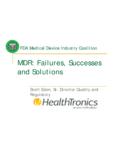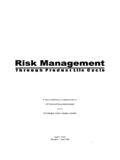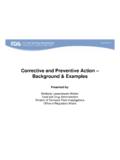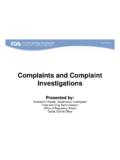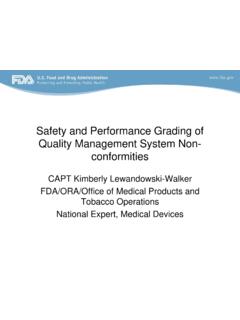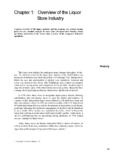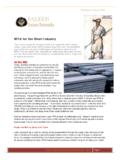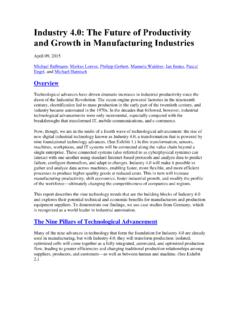Transcription of FDA Medical Device Industry Coalition
1 ISO 14971: Overview of the standard April 2, 2010. FDA Medical Device Industry Coalition ISO 14971: Overview of the standard Risk Management Through Product Life Cycle: An Educational Forum William A. Hyman Department of Biomedical Engineering Texas A&M University Medical devices . Application of risk management to Medical devices - 14 pages in body - 63 pages in 10 Annexes April 2010 2. William Hyman, 1. ISO 14971: Overview of the standard April 2, 2010. Contents Scope Terms and definitions General requirements Risk analysis Risk evaluation Risk control Residual risk acceptability Report/documentation Post-production April 2010 3. Contents Scope Terms and definitions General requirements Risk analysis Risk evaluation Risk control Residual risk acceptability Report/documentation Post-production April 2010 4.
2 William Hyman, 2. ISO 14971: Overview of the standard April 2, 2010. Annexes Rationale Overview Identifying Device characteristics that have risk Risk concepts Examples of hazards Risk management plan Techniques In vitro Biological hazards Residual risk April 2010 5. Observations on 14971. It is voluntary . It is cited and recognized by FDA. A search within FDA for ISO 14971. produces 564 items! It's useful application requires knowledge and diligence April 2010. William Hyman, 3. ISO 14971: Overview of the standard April 2, 2010. Observations on 14971. The reasons to undertake risk management (guided by 14971). are that: Reducing risk is a good thing Compliance is also a good thing Don't let the compliance imperative overwhelm the risk control imperative April 2010.
3 Direct citations of 14971 in submitted documents From an MDR: risk analysis (performed according to ISO 14971 2000 . From a 510(k) Summary: risk analysis preformed identified by ISO 14971and QSR. and internal procedures for risk analysis. April 2010 8. William Hyman, 4. ISO 14971: Overview of the standard April 2, 2010. General principles Risk is commonly described as having two principle components: > Severity if the harm occurs > Probability of the harm occurring April 2010 9. A few definitions Harm is the adverse event Hazard is the potential cause of the harm Note: You can detect a hazard before it causes harm, but detecting harm means the harm already occurred Safety is the absence of unacceptable risks But unacceptable to whom?)
4 April 2010 10. William Hyman, 5. ISO 14971: Overview of the standard April 2, 2010. General principles Risk management is something that you have to actively do It is not simply a byproduct of general good intentions and good engineering April 2010 11. General principles Risk can often not be reduced to zero but this is not an excuse for all hazards and harms There may be residual risks after appropriate risk evaluation and control Residual risks must undergo acceptance and communication activities 12. William Hyman, 6. ISO 14971: Overview of the standard April 2, 2010. The process part 1. Risk Analysis Risk Risk Evaluation Assessment Risk Control April 2010 13. The process part 1.
5 Risk Analysis Cycle! Risk Risk Evaluation Assessment Risk Control April 2010 14. William Hyman, 7. ISO 14971: Overview of the standard April 2, 2010. The process part 2. Risk Analysis Risk Evaluation Risk Control Cycle! Acceptability? 15. The process part 3. Risk Analysis Risk Evaluation Risk Control Risk Management Acceptability? Cycle! Repor t Post Production 16. William Hyman, 8. ISO 14971: Overview of the standard April 2, 2010. A note on post production Manufacturing deviations Complaints and complaint handling CAPA. Capture Recalls Evaluate Act Evaluate April 2010 17. General requirements in 14971. (Section 3). A formal (documented) process and plan in place Management commitment Resources Personnel Qualified personnel Documented results April 2010 18.
6 William Hyman, 9. ISO 14971: Overview of the standard April 2, 2010. Risk analysis (Section 4). Intended use and misuse Risk related characteristics Hazard identification > known and foreseeable Risk estimation > systematic > based on available and general information April 2010 19. Risk evaluation (Section 5). Manufacturer determined criteria for Risk acceptability decision making There is not a predetermined, all purpose acceptable level of risk > no equation > no regulation April 2010 20. William Hyman, 10. ISO 14971: Overview of the standard April 2, 2010. Risk control (Section 6) - Engineering Elimination by (re)design Protective measures to protect against the risk both physical and alarms Information (IFUs, training).
7 Preferably in this order! You shouldn't try to fix a dangerous design with a warning (if you could have reasonably designed it out)! April 2010 21. Risk control (Section 6) -Management Residual risk evaluation after controls are applied Another round of acceptance decision making including Risk/benefit analysis (Section ). > an effort to make otherwise unacceptable risks acceptable . which is potentially confusing If accepted --- disclosure decision making April 2010. William Hyman, 11. ISO 14971: Overview of the standard April 2, 2010. Overall risk (Section 7) - Management After all individual risk control activity has been done . then decision making applied to complete design Note: assessing the collective risk that results from the individual risks is a challenging and imprecise procedure April 2010 23.
8 Report (Section 8). Review pre product release Appropriately implemented Overall residual risk is acceptable Post production processes are in place Documented April 2010 24. William Hyman, 12. ISO 14971: Overview of the standard April 2, 2010. Post production(Section 9). Collect and review Attention to previously unrecognized risks Attention to severity or rate of occurrence above originally estimated Include feedback into risk management process itself April 2010 25. Annexes Rationale Overview Identifying Device characteristics associated with risk Risk concepts Examples of hazards Risk management plan Techniques In vitro Biological hazards Residual risk 26. William Hyman, 13. ISO 14971: Overview of the standard April 2, 2010.
9 Annex C Questions -examples Intended and means of use (& user). Materials and components Sterile, or user sterilization Measurements and data interpretation Use in conjunction with . interfacing Unwanted outputs ( Noise, heat, EMI). Susceptible to environment, forces, etc. 27. Annex C Questions (cont). Software (& menus). Reuse, intended and single use Installation & use training New manufacturing processes Transmittal of user information User interface issues human factors distractions alarms predictable misuse 28. William Hyman, 14. ISO 14971: Overview of the standard April 2, 2010. Note Lists of questions, lists of hazards, check lists, pull down menus, etc are not a substitute for thoughtful analysis by a knowledgeable person The more unique/different your Device is, the less likely it is that pre-prepared lists will be comprehensive April 2010 29.
10 Annexes Rationale Overview Identifying Device characteristics associated with risk Risk concepts Examples of hazards Risk management plan Techniques In vitro Biological hazards Residual risk 30. William Hyman, 15. ISO 14971: Overview of the standard April 2, 2010. Annex D Risk concepts Probability and severity scales Qualitative 3 and 5 level scales are shown Severity Catastrophic Death Critical Permanent impairment or life threatening Serious Medical intervention Minor No Medical intervention Negligible Inconvenience or temporary 31. Annex D Risk concepts Probability and severity scales Probability with verbal or numerical descriptors 14971 other Frequent >10-3 highly likely Probable < 10-3 and >= 10-4 will occur Occasional < 10-4 and >=10-5 may occur Remote < 10-5 and >=10-6 possible but unlikely Improbable < 10-6 very unlikely 32.

